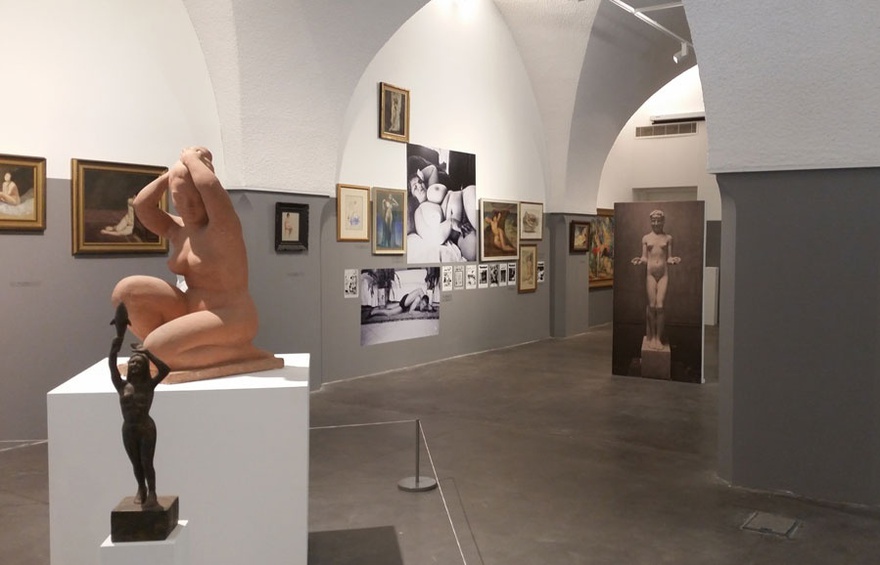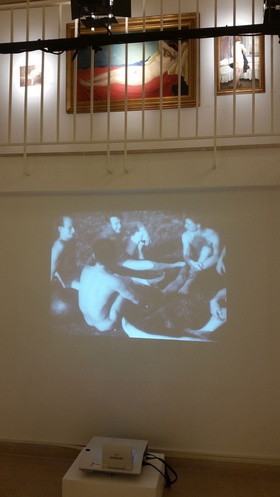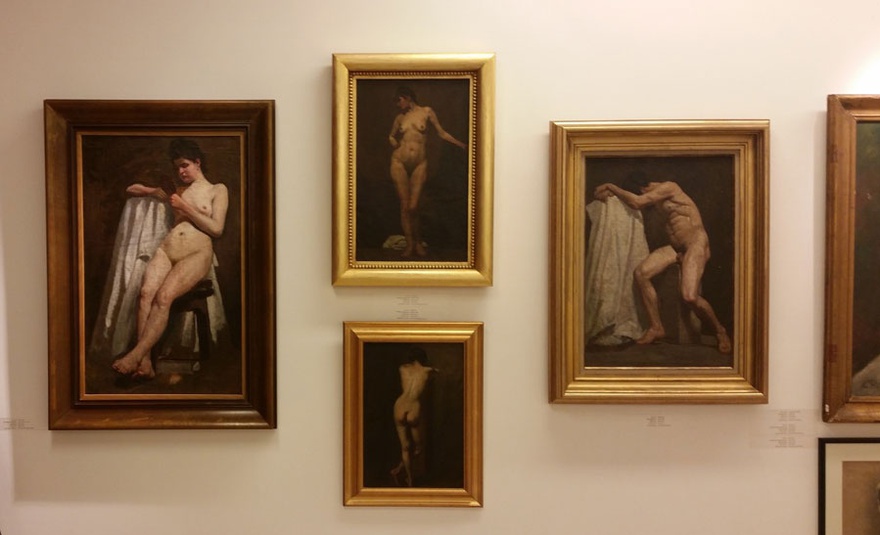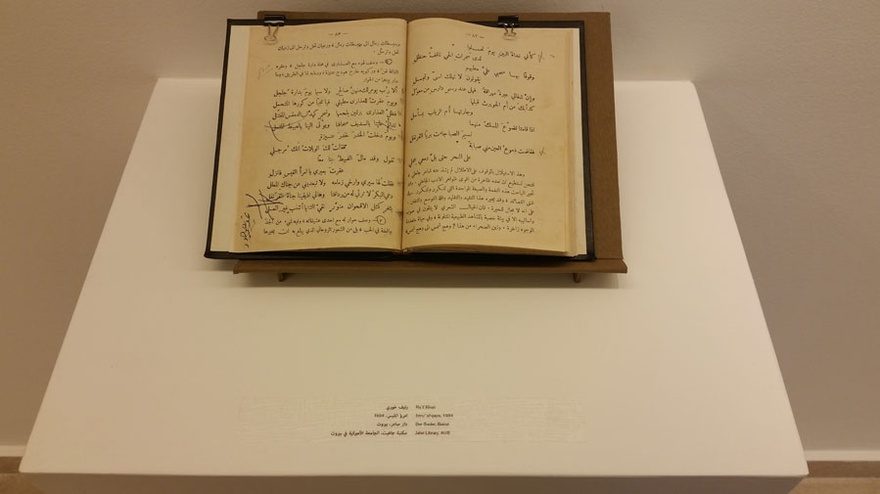Reviews
The Arab Nude
The Artist as Awakener at AUB
The Iraqi poet Maruf al-Rasafi was in great spirits one evening in 1934, drinking araq in a Baghdad café with Amin Rihani, the great Lebanese Arab-American writer and political chronicler. They had been discussing the unveiling movement, and he had declared his support for the complete unveiling of both sexes, male and female, only to suddenly ask, 'Or, did you ask me about the Nude? Yes, I am one of its champions. The Nude in everything. The nudity of women; just as the nudity of this glass!' As Rihani related this exchange in an essayistic story published in the Beirut-based journal al-Makshuf, he explained thatal-Rasafi's idea of the Nude stemmed from a semi-debauched Romantic sense of beauty in the world. The poet had even spoken about a series of encounters with a prostitute, whose veils he removed until she stood nude on the carpet, asserting, 'a woman who has a beautiful face and body is more precious than all Arab monarchies'. At stake in this exchange about the Nude, then, as Rihani understood, was a Gordian knot of Arab modernity: problems of gendered relations, access as power, beauty as resource, intoxication as poetry, desire as idealized and extramarital, all exacerbated by foreign Mandate rule.
A photocopy of Rihani's al-Makshuf article is included in the 150th anniversary showcase exhibition at the American University of Beirut, The Arab Nude: The Artist as Awakener/Ansar al-`Ury: al-Fannan al-Mustanhid. Curated by Octavian Esanu and Kirsten Scheid, this meticulously researched exhibition offers a revelatory chronicle of contested visuality in Mandate Lebanon primarily, but also Egypt, Iraq, Syria, Palestine, and Algeria. It demonstrates in dazzling detail how the naked body offered Arab intellectuals and artists a vast terrain of social and political activation. It could be mediated into flecks of oil paint, the ben-day dots of print media, or the cells of the moving image, become 'enflamed' or made to dance, be held captive, or even be killed (either by the stifling mores of proper society, or by mortal wounds inflicted by persons suffering from its pathologies). Indeed, the Nude could even stand for a salutary directness of living, warranting advocacy by champions. The Arabic title of the exhibition means just that: supporters, or champions, of the Nude. Among its thoroughly modern cohort, there were poets in Baghdad as well as radical modernizers in Beirut such as Fu'ad Hubaysh, a writer and publisher who was also an advocate of the international Nudist movement (al-Makshuf was his journal), and, of course, a legion of artists working to assert their own professional status as champions.
The exhibition is sufficiently extensive to occupy two different galleries, the university's Rose and Shaheen Saleeby Museum in Hamra, and the Byblos Gallery on the campus itself. In the first, the visitor follows a relatively tightly coordinated sequence of investigations of discursive conditions. On the top floor, one may become fascinated by the recurrence of depictions of a bathing scene from the pre-Islamic poetry of Imru al-Qays by Beirut-based painters such as Omar Onsi and Cesar Gemayel, for whom the poet's references to time spent with fair women during 'the day at the pool of Darat-i-Juljul' provided an Arab transcoding of the Susanna and the Elders scene (the mainstay for European painters who needed a pretext to plumb the dynamics of male pleasure via the gaze). Also in the gallery is a 1934 print edition offering new critical analysis of Imru al-Qays, which the young leftist critic Ra'if Khuri had prepared and edited in Beirut – a reconfiguration of literary heritage and its popularization happening concurrently with painterly explorations in the visual sphere. In the downstairs space, several display cases document the intertextuality of the Nudist movement and its championing in Lebanon, from translated novels to exhibition reviews and the Jules Cheret film La Marché au Soleil (1932), which screened in Beirut's Olympia cinema in 1934. Projected in the gallery on a loop, it introduces sequences of picnicking Nudists, breaking clouds, and cavorting women as a backdrop to the more static oil studies of the same period. Two other walls hold evidence of the sheer ubiquity of the Nude in the studio painting practices of Arab artists, from Khalil Saleeby to Ismail al-Shaikhli in Baghdad, and with numerous photographs of smiling students attending 'free' figure drawing sessions at the academies of Europe in between.
The Byblos Gallery space invited a more distracted mode of looking, with clusters of works of two- and three-dimensions distributed around its perimeter as if a Salon in-progress, and its primary documents taking the format of photocopies rather than library originals under plexiglass. One of its most prominent images was also the most explicit in its status as a sexualized object: an enlarged photograph of a woman identified as an 'overweight prostitute' posing as an odalisque in a drawing room or studio of some kind-one of a suite of ten by amateur Lebanese photographer Farid Haddad in the 1920s, now in the collection of the Arab Image Foundation (AIF). It is a close shot from above, requiring the photographer to claim the place of libidinal consumer more directly than the painter who can stand behind an easel and the propriety of the profession (which was never assured in those years, but could always be claimed as a mitigating circumstance). Other kinds of relations to the naked body appear in photographs tracked in photographs of swimming boys and stretching wrestlers, also drawn from the AIF, and works by Jubran Khalil Jubran, in which conjoined bodies form androgynous surfaces of spiritualist ecstasy, hinting at their dissolution into mountains or mist. The conventionality of the Nude as a repeating studio exercise is on evidence as well, in a fascinating double-sided Nude by Onsi: a blond sea goddess painted on one side of the canvas, and a seated dark-haired woman on the other, the former in horizontal orientation and the latter in vertical.
For all its surprises and peculiar delights, this is ultimately a didactic exhibition with a clear commitment to examining the provocation of the Nude in historical terms, without reliance on the clichés of propriety and prohibition that have hitherto structured discussion of the Nude in the region. One of its strengths is that it invites visitors into its inquiry multiple ways, including by attending to the often awkward physical experience of engaging the Nude. At the Saleeby gallery, recordings of period music such as Laure Daccache's Bint al-Moda (recorded around 1941) filled the first room, performing the double function of disrupting the 'slow looking' more typically demanded by the medium of oil painting, and, by its out-of-placeness in the contemporary soundscape, restoring something of the novelty that these paintings would have commanded at the time of their making. Elsewhere in the space, the curators devised installation strategies to heighten visitors' self-consciousness in their own looking as well. As Scheid has demonstrated in previous scholarship, artworks such as À l'exposition (1932) by al-Onsi and the cartoon Souvenir de l'exposition Farrouk (1933–34) by Moustafa Farrouk – both included in the exhibition (the latter in reproduction) – may be understood as artistic explorations of ongoing social contestation over how to look at Nudes. In al-Onsi's image, a gaggle of veiled women cluster around a painting of the Darat-i-Juljul scene, craning to get a look, while in Farroukh's, a pair of out-of-place country folk stand bashfully before one of the artist's own famous Nudes, their own bodies filling the gap of civilizational difference with shadow. As The Arab Nude has been configured, both these postures - the rush of the gaze and the embarrassment of the self – converge upon the surface of another al-Onsi painting. The gallery lighting has been rigged in such a way that any visitor who draws near to look closely will obscure the painting with her own body.
As made painfully obvious by al-Rasafi's araq declarations in Baghdad of 1934, the champions of the Nude were not always champions of living, breathing women. The exhibition does not flinch from this. It even includes videos of readings from artist memoirs that make explicit the discomfiting masculinist quality of the claims that artists made upon their female models. Nor does it allow itself to celebrate artistic achievement or (god forbid) genius. Rather, it is a dense and rewarding exhibition that consistently opens its objects to the extra-artistic territories of social convention and aspiration. To champion the Nude, we learn, was to stand for something far more problematic and therefore substantive than mere emulation of European art conventions. The lasting lesson for the viewer, then, is not about the ubiquity of the Nude in these years. Rather, it is that the aesthetic work of organizing the naked body was already recognized by artists, critics, and many onlookers as political, international, and highly vulnerable to the vagaries of world power.
The Arab Nude: The Artist As Awakener, is on show at the American University of Beirut, until 1st August 2016.









